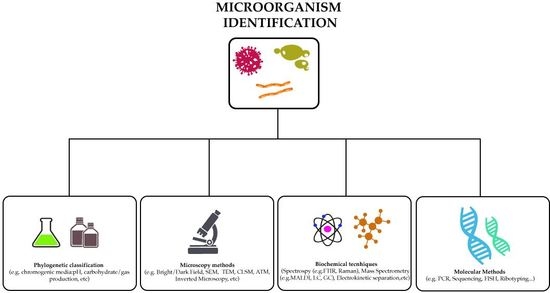Describe the Methods You Used to Identify Bacterium Samples
Your methods depend on what type of data you need to answer your research question. Soil samples and sieve 2 mm pore.

Microorganisms Free Full Text Advances In Chemical And Biological Methods To Identify Microorganisms From Past To Present Html
The sample on the right below is catalase positive.

. This test is used to identify bacteria that can hydrolyze starch amylose and amylopectin using the enzymes a-amylase and oligo-16-glucosidase. This technique is commonly used as an early step in identifying pathogenic bacteria. Finding any bacteria in such samples is abnormal as long as the area from which the sample was taken was first cleaned with an antiseptic to prevent contamination.
3 Surface growth pellicle formation. There are several different microbiology methods that scientists can use to isolate pure cultures of bacteria. Two common methods are streak plate and pour plate techniques.
1 A uniform turbidity. Pouring is the simplest method for bacterial isolation. What are the methods to observe bacteria.
And the Micrococcus spp. Gram stain is a very important differential staining technique used in the initial characterization and classification of bacteria in microbiology. Water blanks 99 ml and 9 ml.
To test whether bacteria contain a catalase enzyme a microbiologist drops hydrogen peroxide into a smear of bacteria on a microscope slide. But whatever method is used the presence of the antigen means that the microorganism is present and. The bacterial isolation includes the following plating methods.
Test for antibodies that protect against infectious agent. When planning your methods there are two key decisions you will make. You can only see a bacteria in 100x oil immersion or other powerful microscope you can see it on 40x.
Different methods can be used to detect the antigen-antibody combination. For the growth of bacteria there should be. Burrells wrist action shaker.
Here the bacterial suspension laden with a huge bacterial population is generally taken. Gram stainingsimple staining acid fast stainkng capsule staining and other staining techinques. A breath test assaying for radioactive carbon dioxide may be used to indicate the presence of Helicobacter pylori In 1908 Orla-Jensen suggested that bacteria be grouped according to their physiology Phage typing is used to distinguish bacterial strains Which techniques are used to help identify and classify bacteria -Microscopic examination.
First decide how you will collect data. 2 Little deposit at the bottom. Common specimens include urine faeces wound swabs.
ZVarious methods used for isolation of bacteria Specimen collection Many different specimens are sent for microbiological examination from patients with suspected bacterial infection. Isolation Methods of Bacteria. This Gram staining test will tell you whether the bacteria is Gram positi.
This basic technique used for bacteria and other microorganisms like fungi especially from soil helps in obtaining isolated colonies where dilutions prevent crowding of colonies. Pipettes 5 ml graduated. Gram staining helps to identify bacterial pathogens in specimens and cultures by their Gram reaction Gram-positive and Gram-negative and morphology coccirod.
If the bacteria contain catalase the mixture bubbles as the hydrogen peroxide decomposes into water and oxygen. To identify novel unknown bacteria the first screening test is Gram staining. By using a pipette take 1 ml of a bacterial sample into the sterile Petri plate.
After completing the Gram stain procedure the technician views the slide under the brightfield microscope and sees purple grape-like clusters of spherical cells Figure 4. Research methods are specific procedures for collecting and analyzing data. The appearance of the discrete masses of growth or colonies that can be grown from isolated bacteria on the surface of the solid medium nutrient agar can be used to study the size of the colonies diameter in mm their outline whether circular entire indented or wavy or.
Tests for antibodies protiens made by white blood cells to protect against invading microbes to bacteria the patient might have produced during infection. The Streptococcus and Enterococcus spp. The technician decides to make a Gram stain of the specimen.
View the full answer. Streak Plating Isolation Technique. Developing your research methods is an integral part of your research design.

Biochemical Tests For Bacterial Identification Microbe Online

Methods Of Classifying And Identifying Microorganisms Boundless Microbiology

Methods Of Classifying And Identifying Microorganisms Boundless Microbiology
No comments for "Describe the Methods You Used to Identify Bacterium Samples"
Post a Comment